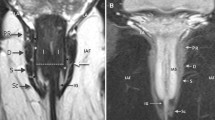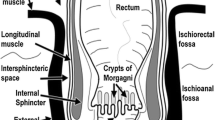Abstract
A broad spectrum of disease, from benign processes to life-threatening pathologies, can cause anal pain. MR imaging (MRI) has become increasingly widely used method over the past two decades for the evaluation of individuals with anorectal symptoms. Although imaging is rarely necessary to determine the etiology of the majority of cases, MRI is particularly useful as a noninvasive method of excluding severe neoplastic conditions. In this article, MRI findings of a number of pathologies such as anal and perianal neoplasms, hemorrhoidal disease, arteriovenous malformation of the perianal region, and anal sphincter lesions (defects, scarring, atrophy) which may lead to fecal incontinence are presented.




















Similar content being viewed by others
References
Ciombor KK, Ernst RD, Brown G (2017) Diagnosis and diagnostic imaging of anal cancer. Surg Oncol Clin N Am 26:45–55
Granata V, Fusco R, Reginelli A, et al. (2016) Radiological assessment of anal cancer: an overview and update. Infect Agent Cancer 12(11):52
Tonolini M, Bianco R (2013) MRI and CT of anal carcinoma: a pictorial review. Insights Imaging 4:53–62
Kochhar R, Plumb AA, Carrington BM, Saunders M (2012) Imaging of anal carcinoma. AJR Am J Roentgenol 199:W335–W344
Surabhi VR, Menias CO, Amer AM, et al. (2016) Tumors and tumorlike conditions of the anal canal and perianal region: MR imaging findings. Radiographics 36:1339–1353
Glynne-Jones R, Northover JM, Cervantes A (2010) ESMO Guidelines Working Group. Anal cancer: ESMO clinical practice guidelines for diagnosis, treatment and follow-up. Ann Oncol 21:87–92
Edge SB, Byrd DR, Compton CC, et al. (eds) (2010) AJCC cancer staging manual, 7th edn. New York: Springer
McMahon CJ, Rofsky NM, Pedrosa I (2010) Lymphatic metastases from pelvic tumors: anatomic classification, characterization, and staging. Radiology 254:31–46
Ryan DP, Compton CC, Mayer RJ (2000) Carcinoma of the anal canal. N Engl J Med 16:792–800
Matalon SA, Mamon HJ, Fuchs CS, et al. (2015) Anorectal cancer: critical anatomic and staging distinctions that affect use of radiation therapy. Radiographics 35:2090–2107
Herzog U, von Flüe M, de Roche R, Curschellas E (1993) Perianal extramammary Paget’s disease. Report of two cases. Eur J Surg Oncol 19:469–473
Jabir S, Khatib M, Ali S, Niranjan N (2013) Perianal Paget’s disease: a diagnostic dilemma. BMJ Case Rep
Kyriazanos ID, Stamos NP, Miliadis L, Noussis G, Stoidis CN (2011) Extra-mammary Paget’s disease of the perianal region: a review of the literature emphasizing the operative management technique. Surg Oncol 20:e61–e71
Billingham RP, Isler JT, Kimmins MH, et al. (2004) The diagnosis and management of common anorectal disorders. Curr Probl Surg 41:586–645
De Toma G, Cavallaro G, Bitonti A, et al. (2006) Surgical management of perianal giant condyloma acuminatum (Buschke-Löwenstein tumor). Report of three cases. Eur Surg Res 38:418–422
Hemper E, Wittau M, Lemke J, Kornmann M, Henne-Bruns D (2016) Management of a giant perineal condylomata acuminata. GMS Interdiscip Plast Reconstr Surg DGPW 21:5
Felt-Bersma RJ, Bartelsman JF (2009) Haemorrhoids, rectal prolapse, anal fissure, peri-anal fistulae and sexually transmitted diseases. Best Pract Res Clin Gastroenterol 23:575–592
Ratto C, Parello A, Donisi L, et al. (2012) Assessment of haemorrhoidal artery network using colour duplex imaging and clinical implications. Br J Surg 99:112–118
Schubert MC, Sridhar S, Schade RR, Wexner SD (2009) What every gastroenterologist needs to know about common anorectal disorders. World J Gastroenterol 14:3201–3209
Kędzierski B, Nowak G, Kuśmierska M, Jaźwiec P, Szuba A (2013) Giant congenital malformation of the perirectal plexus in computed tomography imaging—case report. Pol J Radiol 78:50–53
Bharucha AE (2003) Fecal incontinence. Gastroenterology 124:1672–1685
Boyle DJ, Knowles CH, Murphy J, et al. (2012) The effects of age and childbirth on anal sphincter function and morphology in 999 symptomatic female patients with colorectal dysfunction. Dis Colon Rectum 55:286–293
Dobben AC, Felt-Bersma RJ, ten Kate FJ, Stoker J (2008) Cross-sectional imaging of the anal sphincter in fecal incontinence. AJR Am J Roentgenol 190:671–682
Santoro GA, Fortling B (2007) The advantages of volume rendering in three-dimensional endosonography of the anorectum. Dis Colon Rectum 50:359–368
Regadas FSP, Regadas SMM, Rodrigues LV (2008) Two- and three-dimensional ultrasonography of anatomic defects in fecal incontinence. In: Imaging atlas of the pelvic floor and anorectal diseases Chapter 5. Italy: Springer, pp 27–34
Shek KL, Atan IK, Dietz HP (2016) Can anal sphincter defects be identified by palpation? Female Pelvic Med Reconstr Surg 22:472–475
Coura MM, Silva SM, Almeida RM, Forrest MC, Sousa JB (2016) Is digital rectal exam reliable in grading anal sphincter defects? Arq Gastroenterol 53:240–245
Bollard RC, Gardiner A, Lindow S, Phillips K, Duthie GS (2002) Normal female anal sphincter: difficulties in interpretation explained. Dis Colon Rectum 45:171–175
Terra MP, Deutekom M, Beets-Tan RG, et al. (2006) Relationship between external anal sphincter atrophy at endoanal magnetic resonance imaging and clinical, functional, and anatomic characteristics in patients with fecal incontinence. Dis Colon Rectum 49:668–678
deSouza NM, Puni R, Zbar A, et al. (1996) MR imaging of the anal sphincter in multiparous women using an endoanal coil: correlation with in vitro anatomy and appearances in fecal incontinence. AJR Am J Roentgenol 167:1465–1471
Rociu E, Stoker J, Eijkemans MJ, Laméris JS (2000) Normal anal sphincter anatomy and age- and sex-related variations at high-spatial-resolution endoanal MR imaging. Radiology 217:395–401
Terra MP, Beets-Tan RG, van der Hulst VP, et al. (2006) MRI in evaluating atrophy of the external anal sphincter in patients with fecal incontinence. AJR Am J Roentgenol 187:991–999
Thoua NM, Schizas A, Forbes A, Denton CP, Emmanuel AV (2011) Internal anal sphincter atrophy in patients with systemic sclerosis. Rheumatology (Oxford) 50:1596–1602
Author information
Authors and Affiliations
Corresponding author
Ethics declarations
Funding
No funding was received.
Conflict of interest
The author declare that she has no conflict of interest.
Ethical approval
All procedures performed in studies involving human participants were in accordance with the ethical standards of the institutional and/or national research committee and with the 1964 Helsinki declaration and its later amendments or comparable ethical standards.
For this type of study formal consent is not required.
Rights and permissions
About this article
Cite this article
Erden, A. MRI of anal canal: common anal and perianal disorders beyond fistulas: Part 2. Abdom Radiol 43, 1353–1367 (2018). https://doi.org/10.1007/s00261-017-1306-1
Published:
Issue Date:
DOI: https://doi.org/10.1007/s00261-017-1306-1




